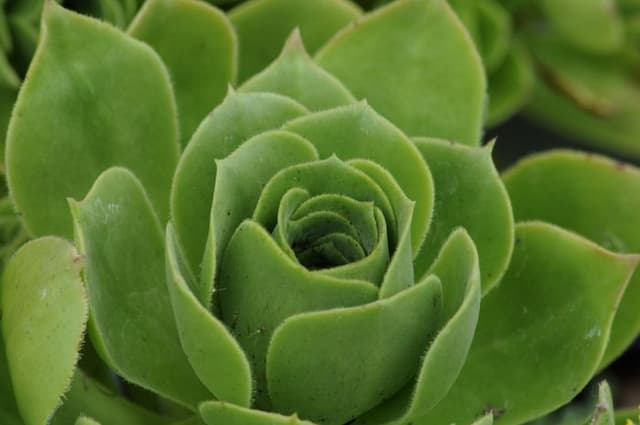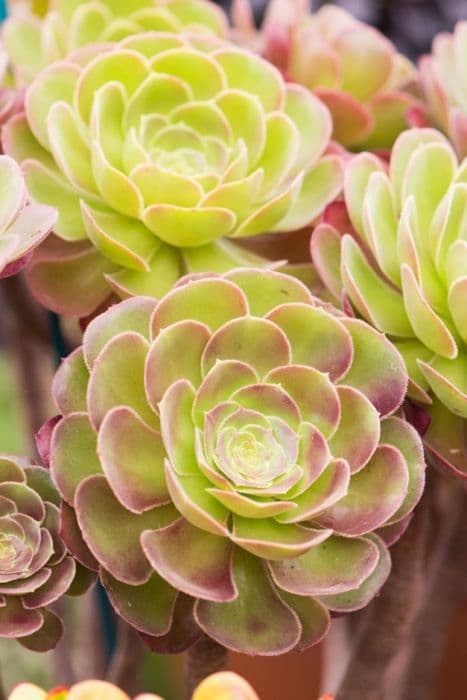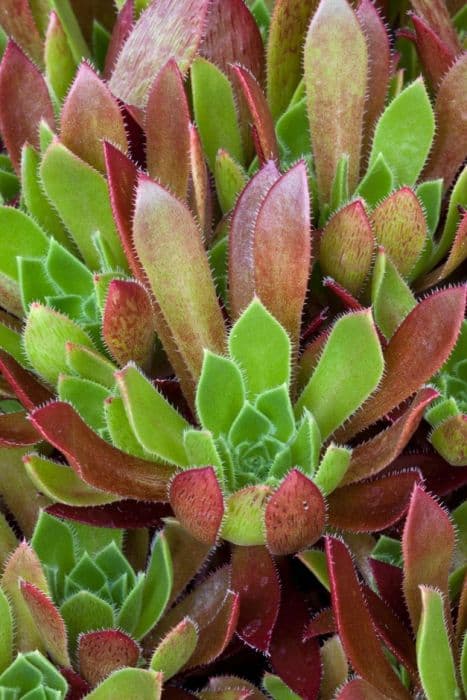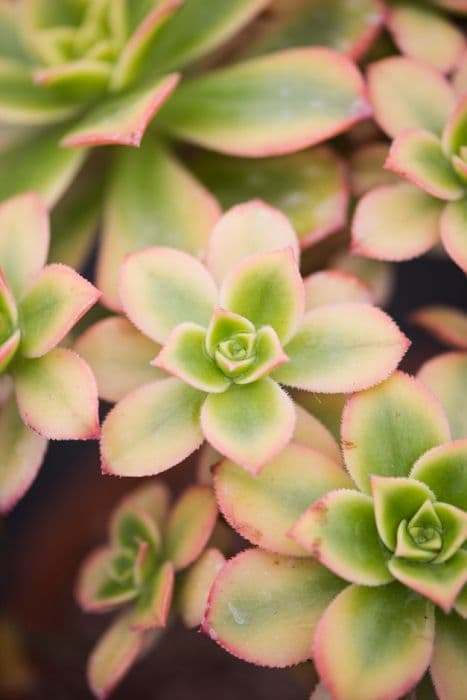Houseleek Sempervivum altum

ABOUT
Sempervivum altum, commonly known as houseleek, presents a stunning display of rosette formations. Each rosette is composed of tightly packed, fleshy leaves that often exhibit pointed tips. The leaves can range in color from deep greens to reddish hues, and in some varieties, they may have a delicate layer of fine hairs or a waxy coating, adding to their unique texture. The houseleek's ability to store water within its leaves allows them to have a plump and robust appearance, making them highly valued in drought-resistant plantings. Over time, these rosettes can multiply, forming dense clusters that spread across the surface of the soil they inhabit, giving them an almost carpet-like look. The striking look of the houseleek is further enhanced when it blooms. Flower stalks emerge from the center of some rosettes, rising above the foliage and culminating in star-shaped blossoms. The flowers, contrasting with the leafy greens below, are typically a hue of pinks, reds, or purples. However, after flowering, the individual rosette that produced the blossom typically dies, giving way to the surrounding rosettes to continue growing and propagating. Despite their seeming delicacy, houseleeks are known for their hardiness and ability to withstand tough conditions, which adds to their appeal for gardeners looking for resilient and attractive plants.
About this plant
 Names
NamesSynonyms
Houseleek, Roof Houseleek, Hen and Chicks, Liveforever.
Common names
Sempervivum ciliosum var. altum, Jovibarba globifera subs. hirta var. altum
 Toxicity
ToxicityTo humans
Sempervivum altum, commonly known as Houseleek, is not considered to be toxic to humans. Ingesting parts of this plant typically does not lead to poisoning or serious health issues. However, like any non-food item, if ingested in large quantities it could potentially cause stomach discomfort or indigestion.
To pets
For pets, Houseleek (Sempervivum altum) also does not display toxicity. It is generally regarded as safe, and ingestion should not cause poisoning in animals such as dogs and cats. Similar to humans, consuming large amounts might cause mild gastrointestinal upset, but it is not known to be harmful to pets under normal circumstances.
 Characteristics
CharacteristicsLife cycle
Perennials
Foliage type
Evergreen
Color of leaves
Green
Flower color
Red
Height
6 inches (15 cm)
Spread
12 inches (30 cm)
Plant type
Succulent
Hardiness zones
5
Native area
Peru
Benefits
 General Benefits
General Benefits- Drought Tolerance: Sempervivum altum, commonly known as houseleek, has the ability to survive prolonged dry periods, making it suitable for xeriscaping and water-wise gardens.
- Low Maintenance: Houseleeks require minimal care and do not need frequent watering or fertilizing, which makes them an ideal plant for novice gardeners or those with limited time.
- Cold Resistant: This species can tolerate cold temperatures and is hardy in many climates, allowing it to survive in outdoor gardens year-round in many regions.
- Aesthetic Appeal: With its rosette form and variety of colors, houseleeks add unique visual interest to rock gardens, rooftop gardens, and container arrangements.
- Insect-Resistant: Houseleeks are not prone to many pests, reducing the need for chemical insecticides and contributing to a more natural garden ecology.
- Fits Small Spaces: Their compact size makes houseleeks ideal for small gardens, terraces, and balconies where space is at a premium.
- Soil Adaptation: They can thrive in poor, gravelly, or sandy soils where many other plants would struggle, making them excellent for challenging garden spots.
- Propagation Ease: Houseleeks readily produce offsets (pups) that can be easily propagated to expand the garden or share with others.
- Versatility in Landscaping: They can be used as ground cover, in crevice and wall gardens, or to fill spaces between stepping stones, providing diverse landscaping uses.
- Evergreen: As an evergreen plant, houseleeks provide year-round color and texture to the garden, even when other plants are dormant.
 Medical Properties
Medical PropertiesThis plant is not used for medical purposes.
 Air-purifying Qualities
Air-purifying QualitiesThis plant is not specifically known for air purifying qualities.
 Other Uses
Other Uses- Sempervivums, commonly known as houseleeks, are used as living roof coverings, offering not only aesthetic appeal but also additional insulation and protection to structures.
- These resilient plants can be employed in rock gardens to create intricate alpine landscapes, mimicking their native mountainous habitats.
- Houseleeks are often utilized in xeriscaping, a landscaping method that reduces or eliminates the need for irrigation, making them perfect for drought-prone areas.
- Enthusiasts of miniature gardening incorporate Sempervivum altum to create fairy gardens or small-scale scenes that invite imaginative inspiration.
- Due to their thick, fleshy leaves and attractive rosette patterns, houseleeks are used as natural art subjects for botanical illustration and photography hobbies.
- They can also be used as a living mulch to suppress weeds, retain soil moisture, and provide year-round ground cover with minimal maintenance.
- Sempervivum altum can be planted in cracks of stone walls or walkways, where their resilience allows them to thrive and beautify otherwise barren spaces.
- These plants are sometimes planted on graves as a symbol of everlasting life and love due to their hardy nature and year-round presence.
- Houseleek leaves have been traditionally used to acidify milk for cheese production in some rural European cultures, leveraging their natural acidic properties.
- They are utilized in educational projects to teach about succulents, their adaptations to hostile environments, and survival strategies of plants.
Interesting Facts
 Feng Shui
Feng ShuiThe plant Sempervivum, commonly known as Hen and Chicks, is not used in Feng Shui practice.
 Zodiac Sign Compitability
Zodiac Sign CompitabilityThe plant Hen and Chicks is not used in astrology practice.
 Plant Symbolism
Plant Symbolism- Perseverance: Sempervivum altum, commonly known as "Houseleek," is renowned for its ability to thrive in harsh, rocky environments, symbolizing resilience and the ability to endure challenging conditions.
- Protection: Historically, Houseleeks were planted on rooftops to prevent lightning strikes and fire, representing safeguarding and a shield against harm.
- Longevity: The name "Sempervivum" means "live forever" in Latin, symbolizing long life and immortality, as these plants can survive for many years and regenerate readily.
- Self-Reliance: Houseleeks are succulents that store water in their leaves, which allows them to withstand drought. This characteristic embodies independence and self-sufficiency.
 Water
WaterHens and Chicks should be watered thoroughly once every 1-2 weeks during the active growing season. It is crucial to let the soil dry out completely between waterings to prevent root rot. When you do water, apply it directly to the soil and not the rosettes, using approximately 1 gallon for a medium-sized pot, ensuring even moisture distribution. During winter months, reduce watering to once a month or less, depending on the humidity and temperature conditions where the plant is kept.
 Light
LightHens and Chicks thrive best in full sun to partial shade conditions. They should receive at least 6 hours of direct sunlight each day. The ideal spot for these plants would be a south-facing window or an area that has bright, indirect light throughout the day to maintain their vibrant color and compact rosette form.
 Temperature
TemperatureHens and Chicks are hardy and can tolerate a wide range of temperatures, generally preferring conditions between 65°F and 75°F for optimal growth. They can survive in temperatures as low as 20°F but should be protected from frost to prevent damage. The maximum temperature tolerated is around 90°F, although they prefer cooler temperatures if possible.
 Pruning
PruningHens and Chicks benefit from occasional pruning to remove dead leaves and spent flower stalks to encourage healthy growth and maintain their attractive appearance. Pruning is typically done in the spring or early summer, and only the dead material should be removed. Remove flower stalks after blooming to focus the plant's energy on producing offsets rather than seeds.
 Cleaning
CleaningAs needed
 Soil
SoilSempervivum, commonly known as Hen and Chicks, thrives in well-draining soil with a mix of equal parts potting soil, coarse sand, and perlite or pumice. The ideal soil pH for Hen and Chicks is slightly acidic to neutral, around pH 6.0 to 7.5.
 Repotting
RepottingHen and Chicks can be repotted every two to three years or when it outgrows its container. Ensure that the new pot allows for proper drainage and has fresh, suitable soil.
 Humidity & Misting
Humidity & MistingHen and Chicks prefers low to average humidity levels and is well-adapted to dry conditions typical to its native rocky slopes.
 Suitable locations
Suitable locationsIndoor
Place Hen and Chicks in bright light and well-draining soil.
Outdoor
Plant Hen and Chicks in full sun and gritty, well-draining soil.
Hardiness zone
3-8 USDA
 Life cycle
Life cycleSempervivum altum, commonly known as High Houseleek, begins its life cycle with seed germination in well-draining soil with high grit content, typically in spring or early summer. The seedlings develop into rosettes, which are capable of photosynthesis and will grow gradually, acquiring nutrients and water through their succulent leaves. As the plants mature, they produce offsets, or "pups," around their base, which can be separated and rooted to grow new plants, exhibiting a vegetative form of reproduction. After several years, when the rosette reaches maturity, it sends up a flower stalk during the summer, which will produce star-shaped, reddish-purple flowers that are pollinated by insects, leading to seed formation. Once flowering is complete, the main rosette typically dies, a phenomenon known as monocarpic death, but the plant's lifecycle continues through the offsets. The seeds, once released, are dispersed by wind and, if landing in suitable conditions, will begin the life cycle anew.
 Propogation
PropogationPropogation time
Spring-Summer
The most popular method of propagation for Sempervivum altum, commonly known as Hens and Chicks, is through offsets. These are the small rosettes that form at the base of the parent plant. Once they have formed a few roots and have grown to a size that is easy to handle, typically around 2 inches (about 5 centimeters) in diameter, they can be gently twisted or cut off and replanted into well-draining soil. This is best done in the spring or early summer, which gives the offsets the entire growing season to establish themselves. The new plants should be watered regularly but allowed to dry out between waterings to mimic their natural arid conditions.









